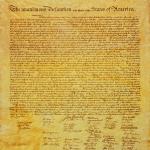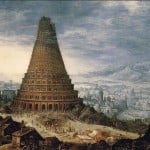When I was a kid, I loved wandering in the barn on my grandfather’s farm. The barn had been built around a two-story log house. In the loft of the barn was a jumble of old farming equipment. My favorite piece of equipment there was what was known as a stitching horse. This was a bench used for harness repair.
A stitching horse consisted of a wooden bench with a pair of wooden arms about two feet long. By stepping on a pedal under the bench, one could squeeze and release the wooden arms. This served as an extra pair of hands when fixing the leather harness for horse farming. What amazed me most about the stitching horse was how old it must have been, yet it was still in working order. The stitching horse had only one problem, one reason for being in the loft of a barn rather than in a workshop: on our farm, the stitching horse had outlived its usefulness. We were farming with tractors. Everything was made of steel. (Stitching horses are still used for leather working, btw.)
My grandfather’s ingenious stitching horse still worked perfectly well. But it was an excellent answer to a question that wasn’t being asked anymore on our farm.
MAYBE A GOOD IDEA IS ALWAYS HERESY
In the early 1840s, just when Transcendentalism was stealing the younger generation from Unitarian churches, Unitarian minister Theodore Parker wrote a sermon he called “Discourse on the Transient and Permanent in Religion.”
Parker claimed that religious thinking changes over time. Scripture—the bible—, for example, was to Parker a transient means of delivering the truth and had for the most part outlived its usefulness. All the accretions—the miracles and miraculous stories—were antique and needed to be consigned to the loft.
The permanent, Parker argued, consisted of the ethical ideas in scripture that could lead each person toward a deeper understanding of meaning and purpose. (In this, Parker was much like Thomas Jefferson, who took a razor to the Christian scriptures in an attempt to make a text that was not offensive to basic good sense.) Parker’s ideas were heresy to the old white guys who made up his ministerial fellows. And a breath of fresh air to the upstart Transcendentalists.
A hundred and seventy-five years later, Parker’s is still a heretical proposition. In most Unitarian Universalist congregations other scriptures have been added to the Christian ones—Hindu, Buddhist, Muslim and what-have-you, but the old contention remains: that traditions—scriptures and religions—of the past contain truth and therefore must be studied and respected. Isn’t this view saying, “yes, we may have implements made of steel, but you have to use that stitching horse when you work on them”?
RESPECT THE STITCHING HORSE!
What is permanent is the human condition. Not the religions that human beings have invented to cope with the human condition. The situation remains the same: the seeds must go into the ground before we can have a harvest. The means of sowing those seeds, however, keeps changing.
Time has shown that Parker was correct, and even more correct than he knew: more and more of religious traditions show their transience with time. The once ubiquitous stitching horse is now an antique or a speciality device.
What’s transient and what’s permanent? Truth appears in all human religions in the same way that utility resides in all human tools: that’s what they’re designed to do, religions—grapple with the truth of the human condition.
Yet the only truth that religions communicate are truths of the human heart. Truths concerning meaning and purpose and right action. So, what are the truths of religions? What’s permanent? You. Your essence. Your human essence. Is that enough? Well . . . it has to be.
Because that’s all we get.











